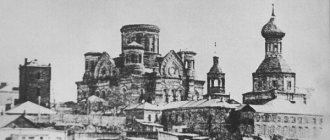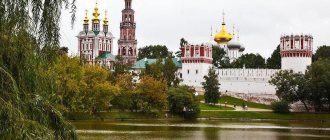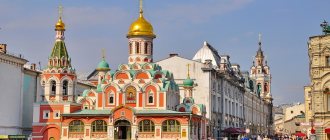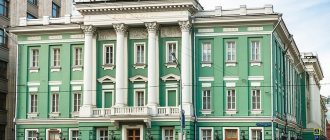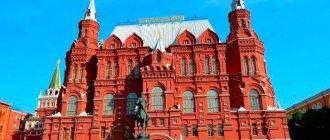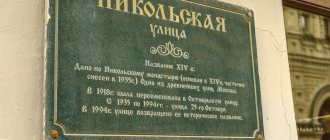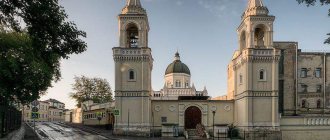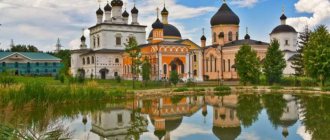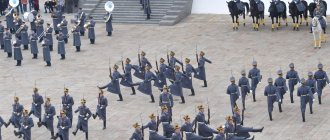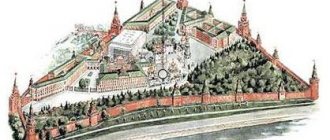Ascension Monastery in Moscow. There is no exact information about the date of its formation on the territory of the Moscow Kremlin, but researchers believe that this happened in 1386.
It is also unknown who was the founder of the monastery, although according to legend it is considered to be the wife of Prince Dmitry Donskoy, Evdokia Dmitrievna, who received the name Euphrosyne of Moscow in monasticism.
History[ | ]
Ascension Cathedral. Drawing from the beginning of the 19th century. Miniature from the Facial Chronicle depicts the funeral of Ivan the Terrible’s wife, Queen Anastasia, 1560. Voznesenskaya Square, 1900s. In the Church of St. Catherine, 1890s. Catherine’s Church. On the right is the Church of Mikhail Malein, 1882
Base[ | ]
The Ascension Monastery was founded no later than 1386 and became the third convent in Moscow after Alekseevsky and Rozhdestvensky. The first wooden church of the monastery - in the name of the Ascension of the Lord - was founded by Grand Duchess Evdokia Dmitrievna, wife of Dmitry Donskoy. Near the temple there was the grand palace and the tower of Evdokia[2][1]. In 1407, the widowed Evdokia took monastic vows under the name of Euphrosyne. By this time, the former grand ducal mansions had already been occupied by cells. In the same year, Evdokia ordered the foundation of a new stone Church of the Ascension. After living as a monk for several weeks, she died and was buried in the church under construction. According to legend, candles were lit at her coffin and healings were performed. Evdokia began to be considered the patroness of Moscow, she was named Venerable Euphrosyne of Moscow
[3][4][5].
The construction of the cathedral was continued by Grand Duchess Sofya Vitovtovna, the wife of Vasily I. Due to the Moscow fires, the cathedral was built over several decades, but it was never finished. In 1467, Princess Maria Yaroslavna, the widow of Prince Vasily II, ordered the unfinished cathedral to be dismantled and a new one built in its place. Vasily Ermolin, who was entrusted with the construction, preserved the building, repositioning the vaults and lining the walls with new bricks. An exact description of the temple has not been preserved. Presumably, it was made of white stone with carved facade decoration. In 1468, the stone cathedral was consecrated in honor of the Ascension of the Lord by Metropolitan Philip of Moscow and became a tomb for the Moscow queens. The nuns of the monastery were engaged in ruel, sewing towels and lace, and cooking for nuns[3][6].
16th century[ | ]
The completed temple repeatedly suffered from fires, and in 1518 Vasily III began construction of a new stone cathedral. It was erected on the existing foundation by the architect Aleviz Fryazin, who by that time had completed the construction of eleven churches in the Moscow suburb. According to historian Peter Maksimov, the cathedral was four-pillared with three apses. After the construction of the Novodevichy Convent in the 1520s, Voznesensky began to be called Starodevichy[3][6].
In 1527, the St. George Church was built south of the Ascension Cathedral. It was founded on the site where a white stone sculptural icon of St. George the Serpent Fighter previously stood. The church was single-domed with three apses, the facades were divided into sections[6]. At the end of the 16th century, by order of Tsar Fyodor Ioannovich, the cathedral was again dismantled due to its disrepair and rebuilt in the forms of the Archangel Cathedral, as a replica. In the 1550s, the monastery was decorated with new icons[7].
After the end of the Time of Troubles in 1613, Martha, the mother of Tsar Mikhail Fedorovich, settled in the Ascension Monastery. Above her cell, where she lived for 18 years, the coat of arms of the Russian kingdom was installed[3].
The Ascension Monastery received special attention from the royal family. Kings and queens visited the monastery tomb on Mother's Saturday, Forgiveness Sunday and Easter. Archdeacon Paul of Aleppo, son of the Patriarch of Antioch Macarius, recalled:
| The Tsar [Alexey Mikhailovich] turned to the monastery of nuns, which in honor of the Divine Ascension... the abbess with the nuns stood waiting at that time; the king made three bows in the snow in front of the icons above the monastery gates, and bowed his head to the nuns, who answered him in the same way and brought the icon of the Ascension and large black bread, which was carried by two; he kissed him.”[8]. |
XVII-XVIII centuries[ | ]
At the beginning of the 17th century, in the monastery, Maria Nagaya recognized False Dmitry I as her saved son. His fiancée Marina Mnishek lived in the cells before the wedding. Other brides also lived in the monastery a few days before the ceremony[9].
Under Mikhail Fedorovich in 1617, the wooden church of Mikhail Malein was built in the southeastern part of the monastery. It was rebuilt into a two-tier stone building with a chapel of Theodore of Perga in 1634 according to the design of Bazhen Ogurtsov and Semeiko Bely. There was a church on the top floor and two cells on the bottom floor. Adjoining the church from the west was a common refectory, above which rose a bell tower with nine bells[10][6].
At the end of the 17th century, the monastery owned 2,128 households. In 1706-1710, the annual monastic income was 3,270 rubles. He also owned estates and courtyards in different districts: Moscow, Borovsk, Vladimir, and had farmsteads and vegetable gardens in Moscow - in Zaryadye, Khamovniki and Staraya Basmannaya. The monastery sacristy contained royal gifts, including the golden crosses of Mikhail Fedorovich and the golden vessels of Alexei Mikhailovich[4].
Under the leadership of the architect I. G. Ustinov, new cells were erected in 1724 and the old ones were repaired. In 1729, the Ascension Cathedral was covered with iron[11].
At the beginning of the 18th century, artificial willow branches made by the nuns of the monastery were sold on Red Square during Palm Week. At this time, a school was organized for noble girls, who were taught literacy, etiquette, church singing and ruel[3][12].
In the 1730s, two chapels were built in the Ascension Cathedral: the Assumption chapel, founded by the brother of Ivan Alekseevich’s wife, and in the name of the icon “Joy of All Who Sorrow,” built by Empress Anna Ioannovna[3]. Seven years later, the monastery was damaged in a major fire, as a result of which the Church of Mikhail Malein and the bell tower burned down. The restoration of the monastery was led by the architect Ivan Michurin[11].
XIX-XX centuries[ | ]
In 1808, by order of Alexander I, the architect Carl Rossi began to build a new Catherine Church on the site of the Church of St. George. Construction was interrupted by the War of 1812; five years later, its finishing was completed by architect Alexey Bakarev. The temple in the neo-Gothic style overlooked Spasskaya Street and occupied almost the entire southern side of the monastery. The facade consisted of a series of large three-quarter columns, triangular pediments, lancet window and door openings. It was decorated with sculptural and ornamental details characteristic of the Gothic style. Two chapels were built in it - the Nativity of John the Baptist and the Icon of Our Lady of Kazan[11].
During the capture of Moscow, the French army plundered the monastery and expelled the nuns. Most of the property was preserved thanks to Abbess Afanasia, who managed to take the wealth from the sacristy to Vologda. The monastery also managed to hide the relics of Tsarevich Dmitry, found in the Archangel Cathedral. After the army left and the monastery was restored, it was reconsecrated in 1814[13][7].
By 1894, the Ascension Monastery occupied an area of 1818 square fathoms. In the middle of the monastery square stood the Ascension Cathedral, on the south side was the Church of the Great Martyr Catherine, in the south-eastern corner was the Church of Mikhail Malein. All the buildings of the monastery were covered with iron and painted with copper [14].
At the end of the 19th century, the monastery belonged to the first class. He owned 195 acres of land, there were 62 nuns and 45 novices[15]. Description of the Ascension Monastery for 1883:
According to the lists, the Voznesensky Monastery is considered the first of the women's monasteries in Russia. There are about 40 nuns in it; Since ancient times, it has been famous for the rule of nuns and strictly adheres to the regulations: it is closed to the entire monastery, where they learn to read and sing in the choirs, weave lace and embroider with gold. For about three hundred years, artificial flowers, leaves and wax images of angels for willows continue to work there[16].
In 1907, the monastery celebrated the 500th anniversary of the death of the founder of the monastery. After the service, a religious procession took place, in which Princess Elizaveta Fedorovna took part. She presented a golden lamp and flower garlands to Euphrosyne’s coffin[3].
Destruction of the monastery[ | ]
Transfer of the remains of the Grand Duchesses and Queens before the destruction of the Ascension Monastery, 1929 In the
autumn of 1917, during the October Revolution, the walls and domes of the churches were destroyed. Members of the Local Council who visited the Kremlin after the shelling described the destruction:
| First of all, along the way we stopped at the Ascension Convent for women. There was already complete destruction here. In the Church of St. Catherine the Great Martyr, the wall of the upper cornice and the upper arch of the temple were pierced through by an artillery shell[17]. |
Soon the nuns were ordered to leave the monastery. The nuns and the abbess temporarily settled in the church of the Lefortovo hospital. They managed to secretly remove some of the icons and jewelry from the monastery and hide them in the monastery courtyard. But the valuables were found and sent to the Armory; in total, more than 25 pounds of silver were seized. The monastery cells were used as a dormitory for Kremlin service personnel. A gymnasium was built in the church in the name of St. Catherine[3][18].
In 1918, the Kremlin Commission was established to work on the restoration and preservation of Kremlin buildings. Architects Ivan Rylsky and I. I. Dumoulin were appointed its leaders. In the Ascension Monastery, it was planned to repair the damage and renew the dome covering and plaster. However, insufficient funding did not allow the plan to be fully realized. It was only possible to partially restore the damage caused by the shelling[18].
In December 1918, by the decision of the commission for the confiscation of church valuables, the main miraculous icon of the Church of the Ascension of the Lord, the Mother of God Hodegetria, was transferred to the Chrism Chamber of the Patriarchal Palace, then to the State Historical Museum, and in 1930 to the State Tretyakov Gallery[19].
In 1920, work to maintain the ancient Kremlin buildings was stopped. Due to the lack of major repairs, the condition of the buildings has deteriorated. In 1924, the soil in the monastery subsided and the walls of the buildings collapsed. But no restoration work was carried out[18].
In 1929, at a meeting of the architectural and restoration department, the upcoming project for the construction of a Military School was announced. Initially it was planned to be carried out behind the Kremlin barracks, which were located near the Trinity Tower. But as a result of the meeting, a decision was made to build a school on the territory occupied by the Small Nicholas Palace and the Ascension and Chudov monasteries. Trying to save the monuments from demolition, restorers of the All-Russian Art Scientific and Restoration Center named after Grabar, Dmitry Sukhov and Nikolai Pomerantsev, sent a letter to the Chairman of the Central Election Commission, Mikhail Kalinin, in which they justified the preservation of the monuments. The changes in the historical appearance of the Moscow Kremlin, the expensive foundation and the possible negative impact of the construction of a new building on the monuments located next to it were pointed out. As an alternative, it was proposed to use the territory of the Alexander Garden. However, their petition did not change the demolition decision. The construction manager was Ivan Zholtovsky, who, however, was against the demolition of the monastery. Soon a complaint was made against him and he was suspended from work[20][18].
That same year the monastery was blown up. Thanks to Nikolai Pomerantsev, the sarcophagi with the remains from the tomb were transferred to the Archangel Cathedral. It was also possible to save four icons - the Mother of God Hodegetria, the Mother of God with a candle, Nikita of Novgorod, the Venerable Theodosius, which are currently kept in the Tretyakov Gallery[15][21][22].
The architects tried to make complete measurements of the monastery buildings. Presumably they were not given enough time for a thorough examination. This is evidenced by the memoirs of V.N. Ivanov:
| We drew up a plan for the scientific recording of archaeological excavations, the removal of fragments, convincing that this is all absolutely necessary work, that science should at least have documents about the monuments if fate erases them from the face of the earth. But no matter what, they didn’t care about everything, and the slogan “quick, quick” dominated everything[18]. |
The measurements (crops) of the churches of the Ascension Monastery, made by the Soviet architect-restorer Pyotr Maximov before the destruction of the monastery in 1929, are stored in the A. V. Shchusev Museum of Architecture. These measurements and other historical documents stored in the museum’s archives were included in the book “Chudov and Ascension Monasteries of the Moscow Kremlin”, published in 2021:
| The most important part of the publication is the measurements of the monastery buildings made immediately before their demolition by the architect P.N. Maksimov[23]. |
On the site of the destroyed monastery, in 1932-1934, the building of the Military School named after the All-Russian Central Executive Committee was built according to the design of the architect Ivan Rerberg or Vladimir Apyshkov. It was stylized in Kremlin classicism to harmonize with the neighboring Senate and Arsenal. Later, the Presidium of the Supreme Soviet of the USSR worked in the building, and then divisions of the Administration of the President of Russia[24].
Under Mikhail Fedorovich, the Church of Mikhail Malein was built
Under Mikhail Fedorovich, the wooden church of Mikhail Malein was also built.
In the photo from the end of the 19th century you can see under the number 1 - the Ascension Monastery, 2 - the Catherine Church, and under the number 3 - the Temple of Mikhail Malein
It was rebuilt into a two-tier stone church with a chapel of Theodore of Perga. A church was built on the top floor, and two cells were located on the bottom floor.
On the western side of the church there was a refectory, above which rose a bell tower with 9 bells.
At the end of the 17th century, the monastery owned 2,128 households. And the annual monthly income received from the monastery was 3,270 rubles.
The monastery also owned estates and courtyards in different counties. The sacristy of the monastery contained royal gifts, as well as the golden cross of Tsar Mikhail Fedorovich and the golden vessels of Alexei Mikhailovich.
Alexei Mikhailovich is the second Russian Tsar from the Romanov dynasty. He was the son of Mikhail Fedorovich and his second wife Evdokia. Golden vessels from him were kept in the sacristy of the monastery
In 1724, new cells were erected and the old ones were repaired. In 1729, the cathedral began to be covered with iron.
Soon, in 1730, it was decided to make two chapels in the Ascension Cathedral. One is Uspensky, the second is in the name of the icon “Joy of All Who Sorrow.”
Exactly seven years later, the monastery was badly damaged in a fire, as a result of which the Church of Mikhail Malein and the bell tower adjacent to it burned out.
One of the schema-nuns prayed to the Mother of God in front of the icon, which was located at the tomb of her father. Then, miraculously, the icon ended up in the monastery. It was discovered only after the fire.
The restoration work was carried out by the then famous architect Ivan Michurin.
Modernity[ | ]
“Archaeological windows” and a view of the square on the site of the Chudov and Ascension monasteries, 2021
In the 1990s, work began on studying the tombs of the grand duchesses and queens. It was possible to recover the relics of St. Euphrosyne of Moscow and reconstruct a sculptural portrait of Sophia Paleologus from the skull[3].
In 2004, burials were examined in an underground chamber next to the Archangel Cathedral. Further study of the materials took place in laboratory premises[25].
Thanks to the sketches of the architect Pyotr Maksimov, made in 1929, in 2011 the Moscow Kremlin Museum-Reserve was able to clarify the location of the burials of the 16th century. A total of 32 graves were examined, as a result of which data was obtained on the appearance of the buried, hereditary pathologies and burial rites. Clothes and shoes found in sarcophagi were also restored[25].
In 2014, President Vladimir Putin proposed recreating the historical appearance of the Moscow Kremlin and restoring the Chudov and Ascension Monasteries. The proposal was discussed at a meeting with the mayor of Moscow Sergei Sobyanin, deputy director of the Moscow Kremlin Museums, specialist in ancient Russian architecture Andrei Batalov, rector of the Moscow Architectural Institute Dmitry Shvidkovsky and commandant of the Moscow Kremlin Sergei Dmitrievich Khlebnikov. The participants expressed approval for the idea of restoring the monasteries and agreed on the need for a thorough, comprehensive study of this project[26]. UNESCO experts warned against the construction of monasteries on the territory of the Kremlin[27].
In 2021, the 14th building of the Kremlin was dismantled, and archaeological excavations were carried out in the newly opened area. For the first time, opportunities have opened up for large-scale archaeological study of such a vast area of the Kremlin Hill and the hidden layers of cultural and spiritual heritage of the 12th - early 20th centuries[28]. Research work was carried out by the Institute of Archeology of the Russian Academy of Sciences. In May of the same year, after the excavations were completed, a public garden was laid out[29].
In the Archangel Cathedral, the Moscow Kremlin Museums opened a permanent exhibition dedicated to the history of the Ascension Monastery[30][31], a new tourist route introducing Muscovites and guests of the capital to the history of the destroyed shrines[32].
In the 90s of the 20th century, work began to study the tombs of grand duchesses and queens
In the 1990s, work began on studying the tombs of the grand duchesses and queens.
As it became known, the first wife of Peter I, Sophia Paleologus, the wife of the Russian Prince Ivan III, as well as Princess Theodosia, the daughter of Tsar Mikhail Fedorovich, were buried in them. The wife of Vasily Shuisky is also buried.
2004
this year, burials were examined in the underground chamber next to the Archangel Cathedral
32 graves were examined, as a result of which data was obtained on the appearance of the buried and on the burial ritual. The clothes and shoes that were found in those sarcophagi were restored.
The photo shows the very tombs next to the Archangel Cathedral, according to which the clothes and shoes of the people of that time were created
In 2014, President Vladimir Putin proposed recreating the historical appearance of the Moscow Kremlin and restoring the Ascension Monastery.
UNESCO experts opposed this construction.
In May 2021, the director of the Moscow Kremlin Museum firmly stated that no buildings are planned. In 2021, the 14th building of the Kremlin was dismantled, and archaeological excavations were carried out at this site.
In May 2021, a square was laid out, and in the summer an exhibition dedicated to the Ascension Monastery was held in the Archangel Cathedral.
In December 2021, archaeological windows with found parts of the foundation of the Ascension Monastery appeared on Ivanovskaya Square.
Unfortunately, not one of the temples that once stood was restored. And we can observe the beauty of these monasteries and temples only from the pages of history.
This is what we can now see instead of that Ascension Monastery and the churches closest to it. 2021
Perhaps none of those passing by these places even thought that the famous third monastery in Moscow used to stand on this site.
By leaving a comment, you accept the user agreement
Ascension Monastery in art[ | ]
In 2015, the Moscow Kremlin Museums produced a documentary film “The Abode at the Spassky Gate”. The film uses archival photographs, measurements and plans of the monastery, icons and church utensils located in the Moscow Kremlin Museums[33].
In 2015, the Soyuz TV channel produced another documentary about the history of the monastery, “Voznesensky Monastery: Traditions and Secrets of the Moscow Kremlin.” The filming was attended by experts Sergei Devyatov, head of the Department of Russian History of the Faculty of History of Moscow State University, Archpriest Alexy Ladygin, rector of the Church of St. Euphrosyne of Moscow in Kotlovka, Boris Vinnikov, architect, head of the team of authors who created the graphic reconstruction of the Ascension Monastery, Natalya Sheredega, head of the department of ancient Russian art State Tretyakov Gallery, restoration artist Larisa Yasnova and others. The text is read by TV presenter, chairman of the board of the Evdokia Moskovskaya Charitable Foundation Lyubov Akelina[34].
The third documentary film “Pantheon of Russian Queens” in the “Shrines of the Kremlin” cycle, dedicated to the monastery, was filmed in 2021. The film uses modern graphic reconstructions of the monastery, allowing one to imagine what the monastery looked like in different centuries[35].
Monastic churches[ | ]
Cathedral of the Ascension of the Lord
The wooden Cathedral of the Ascension of the Lord was first built at the end of the 14th century. Then it was rebuilt several times, and in 1587 it was erected in stone in the image of the Archangel Cathedral. It was a four-pillar cross-domed temple with five domes; there were stone tombstones in the walls above the plinth; below, the façade was decorated with a decorative arcade. There were round windows above the altar. The iconostasis of the temple, decorated with Flemish carvings, was made in the Baroque style. After the revolution, it was moved to the Kremlin Cathedral of the Twelve Apostles. At the Cathedral of the Ascension of the Lord, two chapels were also built: the Joy of All Who Sorrow and the Dormition of the Virgin Mary[36][37][6]. Precious deposits from the 17th-18th centuries were kept in the sacristy of the cathedral. Among them are two Gospels, decorated with precious stones, the Smolensk Icon of the Mother of God, embroidered in gold and silver, two altar crosses in gold, donated by Tsar Mikhail Fedorovich[38].
The shrine of the temple was the image of the Mother of God Hodegetria. According to legend, she was saved by Grand Duchess Evdokia during Tokhtamysh's invasion of Moscow in 1382. A hundred years later, the icon was damaged in a fire, and the icon painter Dionysius painted a new image of the Mother of God on the surviving board. On church holidays, the icon was brought out to meet the Tsar and Patriarch for veneration. Currently, the image is kept in the Tretyakov Gallery[3].
Church in the name of St. Michael Malein with a chapel in the name of Theodore of Perga
In the south-eastern corner of the Ascension Monastery there was a stone temple of Mikhail Malein with a side-chapel in the name of the Holy Martyr Feodor. It contained icons of St. Michael Malein, the Protection of the Mother of God. The iconostasis of the church was wooden, decorated with carvings[39].
In the refectory there was an icon of the Lord Pantocrator. The sculpture of St. George the Victorious, made by Vasily Ermolin to decorate the Spassky Gate, was kept in the temple as a shrine icon. After being removed from the tower, the sculpture was placed in the Church of St. George, which by this time had come under the jurisdiction of the Ascension Monastery. In 1808, it was dismantled and a new church was founded in its place, and the sculpture was moved to the church in the name of St. Mikhail Malein. Currently it is kept in the Tretyakov Gallery[39][40].
Temple in the name of the Holy Great Martyr Catherine
The first refectory church of St. Catherine was built in the middle of the 16th century. When building the existing church in 1806-1817, fragments of the dismantled St. Nicholas Cathedral, which stood 50 meters from the church, were used. The southern wall of the temple overlooked the square in front of the Spassky Gate, the northern wall overlooked the monastery courtyard. It was a tall white stone temple with a ribbed dome in the Gothic style and windows made in the form of pointed arches. There were pinnacles and vials above the roof. At the end of the 19th century, a marble iconostasis was installed in it. Two chapels were built in the temple: the southern one - in the name of the Kazan Icon of the Mother of God, the northern one - in honor of the Nativity of John the Baptist[40][6][41].
- The iconostasis of the Ascension Cathedral, transferred to the Church of the Twelve Apostles, 1929
- Church of St. Mikhail Malein next to the Spasskaya Tower, 1914
- Reliquary with the relics of St. Euphrosyne in the Ascension Cathedral, 1890s
During the October Revolution, the walls and domes of churches were destroyed
In the fall of 1917, during the October Revolution, the walls and domes of the churches were destroyed.
Members of the sacred cathedral, after the shelling of the monastery, wrote about the destruction:
“First of all, on the way we stopped at the Ascension Convent for women.
There was already complete destruction here.
In the Church of St. Catherine the Great Martyr, the wall of the upper cornice and the upper arch of the temple were pierced through by an artillery shell.”
The nuns were ordered to leave the monastery and settle temporarily in the church of the Lefortovo hospital.
Some of the icons and jewelry were secretly removed from the monastery and hidden in the courtyard.
The valuables were still found and sent to the Armory.
Some valuables were transferred to the Cathedral of the Twelve Apostles.
The cells of the monastery began to be used as a dormitory, in which Kremlin service personnel lived. A gymnasium was built in the church in the name of St. Catherine.
In 1918, a special Kremlin commission was established to preserve Kremlin buildings. Its leaders were architects Ivan Rylsky and I. I. Dumoulin.
In the Ascension Monastery, it was decided to repair all the damage, as well as update the domes and plaster.
But, unfortunately, there was not enough funding for this project. Therefore, the plan did not come true at all.
Only those places that were heavily damaged by shelling were restored.
In December 1918, one of the church valuables was removed from the monastery - the icon of the Church of Our Lady Hodegetria.
It was first transferred to the Peace Chamber of the Patriarchal Palace, then sent to the State Historical Museum and the State Tretyakov Gallery.
Icon of the Mother of God “Hodegetria” from the first quarter of the 15th century. It was she who was saved during the shelling of the Ascension Monastery. She was rescued and in the end remained in the Tretyakov Gallery
In 1920, work to support and preserve the Kremlin buildings was restored.
Gradually, the condition of the building began to deteriorate, the soil in the monastery completely subsided and the walls of the buildings completely collapsed. But no restoration work was carried out.
Soon, at various meetings, questions were raised about the demolition of the monastery and the construction of a military school there.
Many were against this, but in 1929 the monastery was blown up. The sarcophagi with the remains from the tomb were transferred to the Archangel Cathedral. 4 icons were also rescued and taken away.
1929
this year the monastery was blown up, replaced by a military school
Unfortunately, during the demolition of the monastery, they were unable to establish the measurements according to which the temple was built.
A military school building was built on the site of the destroyed temple.
Abbess of the monastery[ | ]
- Abbess Venedicta, died May 24, 1571
- Abbess Leonida
- Abbess Maremiana (Mariamna) Voronova, died December 1, 1617
- Abbess Euphemia (Polteva), 1622—1629
- Abbess Marfa (Kolycheva), 1629—1636
- Abbess Anastasia (Saburova), 1637—1645
- Abbess Varsanofia (Tirinova), 1646—1648
- Abbess Alexandra (Romodanovskaya), 1649—1651
- Abbess Alexandra (Kikina), 1652—1654
- Abbess Mariamne (Tolstoy), April - July 1655
- Abbess Euphemia (Ovtsyna), 1657—1659
- Abbess Mariamna (Palchikova), 1660—1666
- Abbess Irinarcha (Timiryazeva), 1666—1673
- Abbess Feofania (Pashkova), 1673—1685
- Abbess Varsanofia (Buturlina), 1685—1709
- Abbess Evdokia (Chelishcheva), 1710—1718
- Abbess Venedicta (Danilovna Pushkina), 1718—1730
- Abbess Evstolia Ivanovna (Ladygina), 1730—1740
- Abbess Elena (Ivanovna Rzhevskaya), 1740—1756
- Abbess Anfia (Timofeevna Kireevskikh), 1756—1772
- Abbess Epaphrodita (Milyukova), 1772—1794
- Abbess Tryphena (Sleptsova), 1794—1819
- Abbess Afanasia (Ivanovna Cherkasova), 1820—1861
- Abbess Paisia (Nudelskaya), 1861—1871
- Abbess Sergius (Urusova), 1871-1884
- Abbess Raphaila (Rovinskaya), 1884—1887
- Abbess Seraphima, 1887-1893
- Abbess Evgenia (Vinogradova), 1893—1922[42]
Necropolis[ | ]
Main article: Necropolis of the Ascension Monastery
Since its foundation, the Ascension Cathedral has served as a tomb for women from the grand-ducal and royal families. The relics of St. Evdokia in a silver shrine, Maria Miloslavskaya, Natalya Naryshkina and others were kept near the southern wall. The disgraced princesses were buried near the northern wall, among them Elena Voloshanka and Euphrosyne Staritskaya. The last burial took place in 1731, when Princess Praskovya Ioannovna, daughter of Tsar Ivan Alekseevich, died. The deceased were buried in linen shirts and silk sundresses. Historian Sergei Solovyov wrote that after the Easter service, the sovereigns first went to the Ascension Cathedral to venerate the coffin of their mother, and then to Arkhangelsk, to the coffin of their father. During the dismantling of the temple in 1929, about 70 burials were found. Currently they are in the dungeon of the Archangel Cathedral[43][3][37].
Modern view of the territory[ | ]
- The bush repeats the outlines of the Ascension Cathedral of the Ascension Monastery, 2021
- Square on the site of the Ascension and Chudov monasteries in the Moscow Kremlin, 2021
- View of the Moscow Kremlin cathedrals and the square on the site of the Ascension and Chudov monasteries, 2021
- Flowerbed on the site of the Church of the Great Martyr Catherine next to the Spasskaya Tower, 2021
- Landscaping of the park area on the site of the Church of St. Mikhail Malein, 2021
- Snow-covered square on the site of the Ascension Monastery. View of the Moscow Kremlin cathedrals, 2021
LiveInternetLiveInternet
Quote from Maya_Peshkova's message
Read in full In your quotation book or community!
Ascension Monastery of the Moscow Kremlin
On the left is the Church of St. Catherine of the Ascension Monastery, on the right is the Spasskaya Tower.
Ascension Monastery is a convent destroyed in 1929 in the Moscow Kremlin. It was located near the Spasskaya Tower on the left and almost closely adjacent to the Kremlin wall. In the Middle Ages it served as a burial place for women - representatives of the Moscow grand ducal family.
Ascension Cathedral (1588), drawing from the early 19th century. According to legend, the monastery was founded by Grand Duchess Evdokia, wife of Dmitry Donskoy. The first Ascension Cathedral Church was built of wood. There is no reliable information about the exact date of foundation of the Ascension Monastery, but it is assumed that it was in 1386
Church of St. Michael Malein
In 1407, Evdokia retired to this monastery under the name of Euphrosyne and a few days later she ordered the foundation of a new stone Ascension Cathedral in place of the wooden one. Having lived in monasticism for only a few weeks, on July 7/20, 1407, the nun Euphrosyne died and was buried in the cathedral under construction. The Monk Euphrosyne of Moscow began to be revered as the patroness of Moscow.
led Princess Evdokia Donskaya (died in 1407 at the age of about 55 years). Sculptural reconstruction based on the skull of S.A. Nikitina, 2001.
Her daughter-in-law, Grand Duchess Sofya Vitovtovna, continued construction, but only managed to erect the walls of the cathedral. Eight years later, the cathedral burned to the ground and, having stood unfinished for 50 years, was restored only in 1467 by Grand Duchess Maria Yaroslavna, the wife of Vasily II the Dark. Architect Vasily Ermolin “dressed” the old walls of the cathedral with new ones for durability
P. Chistyakov, “Grand Duchess Sofya Vitovtovna at the wedding of Grand Duke Vasily the Dark”, 1861
Sixteen years later the monastery was again damaged by fire. The Ascension Cathedral completely burned out and was dismantled “for the sake of dilapidation.” In 1519, on the foundation of the first temple, by order of Grand Duke Vasily III, construction of a new Ascension Cathedral began (there is a version that the architect was Aleviz Novy, who by that time had completed the construction of 11 churches in Moscow Posad). In 1588, under Tsar Fyodor Ioannovich, the Ascension Cathedral was built again as an architectural copy (“replica”) of the Archangel Cathedral.
Andre Durand — Saint Catherine Church of the Ascension Convent in Kremlin (1839)
In subsequent centuries, the cathedral suffered greatly during fires and was renovated more than once: under Emperor Peter I, Empresses Anna Ioannovna and Elizaveta Petrovna. However, during the biggest fire of 1737 in the Moscow Kremlin and its destruction by the French in 1812, the Ascension Cathedral was slightly damaged.
“Vladimir Icon of the Mother of God” is the most revered image of the Mother of God in Rus'. Byzantium. 12th century
The main monastery church, the Ascension Cathedral, housed the revered ancient icon of the Mother of God Hodegetria (Guide), which was said to have been saved by Grand Duchess Evdokia during Tokhtamysh's invasion of Moscow in 1382. Exactly one hundred years later, this icon burned down, and then the famous icon painter Dionysius painted a new image of the Mother of God on the burnt board. On Great Holidays, this icon was brought out to meet the Tsar and Patriarch, and they venerated it at the gates of the monastery. Nowadays, the image is kept in the State Tretyakov Gallery.
“Queen Martha denounces False Dmitry.” Colored lithograph based on a sketch by V. Babushkin, mid-19th century 1580, autumn - 1584, March 18
The monastery was used as a residence for royal brides before their wedding. It was here that the widow of Ivan the Terrible, Maria Nagaya, tonsured nun Martha, welcomed Marina Mnishek, who spent several days in the monastery before her wedding to Nagaya’s imaginary son, False Dmitry.
Eduard Gaertner — Kremlin (1838 watercolor) Pushkin Museum of Fine Arts, Gubar collection
In addition to the main Ascension Cathedral, there were two more churches in the monastery. In 1634, Tsar Mikhail Fedorovich Romanov ordered the construction of a new church and dedicated it to his patron saint Mikhail Malein. The bell tower next to this church was built at the end of the 17th century. She stood right behind the Spassky Gate in the depths behind a beautiful lattice. The church was built in just five months by Bazhen Ogurtsov and Semeiko Bely.
Ascension Monastery in the Moscow Kremlin. Catherine's Church. On the right is the Church of Mikhail Malein, photo from the late 19th century.
Saint Catherine Church (Ascension Convent) — interior
The third church in the monastery was consecrated in the name of St. Great Martyr Catherine. At the beginning of the 19th century, Metropolitan Platon initiated the construction of a new church. The temple was supposed to be located on the south-eastern side of the monastery territory, along the northern border of Spasskaya Street. An ancient stone church of St. stood on this site since 1527. George, built under Vasily III.
It contained a white stone equestrian statue of St. George the Victorious, made by Vasily Ermolin to decorate the Spassky Gate. After being removed from the tower, the sculpture was placed in the Church of St. George, which by this time had come under the jurisdiction of the Ascension Monastery. In 1808, the dilapidated church of St. George was dismantled and a new church was built in its place. The sculpture of St. George the Victorious was transferred as a shrine icon to the stone church in the name of St. Mikhail Malein.
The author of the project for the new church of St. Catherine's architect was Carlo Rossi. The grandiose structure, not inferior in size to the cathedral church, was made in the neo-Gothic style. The complex silhouette with numerous turrets and elegant wall decor gave the building lightness and elegance. Construction of the church, begun in 1808, was interrupted by the War of 1812. Only in 1817 was its decoration completed by the architect A. N. Bakarev. It was one of the best monuments in Moscow, built in the neo-Gothic style. Of interest in the interior was the iconostasis, which was lost during the destruction of the monastery. After the abolition of the monastery in 1920, it was planned to house a gymnasium in the church, but the idea was not realized.
Persons buried in it
Reliquary with the relics of St. Euphrosyne in the Ascension Cathedral.
A miniature from the Facial Chronicle depicts the funeral of Ivan the Terrible’s wife, Queen Anastasia.
The first to be buried in the Ascension Monastery was its founder, the Venerable Euphrosyne. Later, the Ascension Cathedral became a tomb for women of the royal family. It contained many graves: “it is interesting that under the floor of the temple there were almost twice as many burials (about 70) as there were tombstones in its interior (35) - the memory of many graves, especially of appanage princesses and children, was lost long ago”
Sofia Paleolog Natalya Kirillovna Naryshkina
Maria Staritskaya. Marfa Sobakina. Elena Glinskaya
Among those buried in the cathedral were Sofia Vitovtovna (wife of Vasily I), Sofia Paleolog (wife of Ivan III), several wives of Ivan the Terrible, starting with Anastasia Romanovna and ending with Maria Fedorovna Naga - the mother of Tsarevich Dmitry, Grand Duchess Evdokia Alekseevna (daughter of Alexei Mikhailovich), Tsarina Maria Vladimirovna (first wife of Mikhail Feodorovich) and Natalya Kirillovna (mother of Peter I), Agafya Semyonovna Grushetskaya wife of Feodor III[3]. The last burial in the cathedral dated back to 1731, when Princess Praskovya Ivanovna (daughter of Tsar Ivan Alekseevich) died.
Praskovya Ioannovna
The Ascension Monastery was badly damaged during the battles for the Kremlin in November 1917: shells destroyed the walls and domes of its churches. In March 1918, the Soviet government moved to the Kremlin, and in October of the same year the monastery was closed. His last nuns, together with the abbess, found temporary shelter at the church of the Lefortovo hospital. They managed to secretly, under robes, remove from the monastery the icon-reliquary “Our Lady of Kazan” (one of the main monastery shrines), utensils and jewelry and hide them in the monastery courtyard, but the Bolsheviks carried out a search there and sent the confiscated valuables to the Armory.
Icon of the Mother of God "Hodegetria". First quarter of the 15th century Byzantium
Two months later (in December of the same year), by the decision of the Commission for the Confiscation of Church Valuables, the main miraculous icon of the Church of the Ascension of the Lord “Our Lady Hodegetria” (renovated in 1482 by Dionysius) was transferred to the Cross (Chirm) Chamber of the Patriarchal Palace (after it was transferred to the State Historical Museum, and in 1930 - to the State Tretyakov Gallery).
In April 1929, on the initiative of the Kremlin commandant R. A. Peterson, a government commission, which included: K. E. Voroshilov, V. V. Shmidt, A. S. Enukidze, examined the buildings of the Chudov and Ascension monasteries and decided to demolish them, clearing the place for the construction of the Military School named after the All-Russian Central Executive Committee.
Transfer of the remains of the Grand Duchesses and Queens before the destruction of the Ascension Monastery. 1929
Anticipating a similar outcome of events, N. N. Pomerantsev, who headed the commission consisting of D. N. Sukhov, V. K. Klein, A. V. Oreshnikov, V. N. Ivanov and other specialists, achieved the allocation of funds and in the shortest possible time organized architectural measurements, photographic recording of monastery buildings, examination of the burials of the Grand Duchesses and Queens and the removal of white stone sarcophagi with remains to the underground chamber of the southern extension of the Archangel Cathedral, where they remain today (except for the relics of Euphrosyne of Moscow, which were transferred on May 28, 2008 to the martyr's chapel War of the Archangel Cathedral[5]).
The iconostasis of the Ascension Cathedral, transferred to the Church of the Twelve Apostles.
To preserve the iconostasis and ancient icons of the Cathedral of the Ascension of the Lord, N.N. Pomerantsev found a place in the cathedral in the name of the Twelve Apostles. The Cathedral of the Twelve Apostles was smaller than the Ascension Cathedral, so the entire iconostasis was not included in it. Pomerantsev placed the remaining parts of the iconostasis - its two rows with six icons (three - the festive row and three - the passion row) in the museum's collections.
View of the Ascension Monastery in the Moscow Kremlin. On the right is Catherine's Church.
Also in 1929, the Ascension Monastery was blown up. All his churches perished, including Catherine’s, which remained the only surviving creation of Karl Rossi in Moscow. On the site of the monastery in 1932-1934. architect I. Rerberg built the building of the Military School named after. All-Russian Central Executive Committee, stylized as Kremlin classicism, so that it would harmonize with the neighboring Senate and Arsenal. Soon the school was removed from the Kremlin and the Presidium of the Supreme Soviet of the USSR began working in the building.
The bush repeats the outlines of the Ascension Cathedral of the Ascension Monastery
In 2011, research continues at the Moscow Kremlin Museum-Reserve during a unique project to study the necropolis of Russian Grand Duchesses and Tsarinas from the Ascension Cathedral of the Kremlin monastery of the same name. After the completion of a complex stage of field research of burials in the underground chamber next to the Archangel Cathedral (September 2004), the main work on studying the materials of the necropolis is now taking place in the laboratory premises of an interdisciplinary working group of researchers.
A square on the site of the Ascension and Chudov monasteries in the Moscow Kremlin.
Since 2011, active work has continued on the third volume, dedicated to the results of research into burials of the 16th century. Archival data made it possible to clarify the placement of burials in the 16th century. and reconstruct the topography of the necropolis for this period. An important source for resolving this issue were the schematic sketches of the architect P. N. Maksimov, made in August 1929 during the removal of sarcophagi with remains from under the floor of the Ascension Cathedral. Will be presented for the first time in a volume on the 16th century. and photographic materials from 1929, reflecting the state of the burials at the time of their opening.”
As a rule, very meager, scattered information has been preserved about the life of people of the Middle Ages, even the most famous, more reminiscent of today's brief news about political events. So-and-so prince was born, inherited the throne, went on military campaigns, went to the Horde, made pilgrimages to monasteries, got married... And what was his life filled with in the intervals between these acts? What kind of illness did you have, what was your character and habits? Unknown. Science knows even less about the fate and life of the great and appanage princesses and queens, princesses and princesses of the 15th - early 18th centuries.
That is why the project carried out at the Moscow Kremlin Museum-Reserve to study the necropolis of the former Ascension Cathedral - the tomb of the Grand Duchesses and Tsarinas - is so important. It is difficult to overestimate what researchers have already done, but they still have a lot to do. Each burial brings new information and poses tasks for historians, anthropologists and restorers, for the solution of which it is often necessary to involve scientists from institutes of the Russian Academy of Sciences, Moscow State University and other research centers.
Commemorative plate from the Ascension Monastery of the Moscow Kremlin. 1697
All the sarcophagi (and there are 56 of them) with the remains of the great duchesses and queens have already been opened and the very difficult stage of studying these burials has been completed. Particularly difficult, strange as it may seem, was the opening of the latest sarcophagi, dating back to the end of the 17th and beginning of the 18th centuries. White stone coffins of this period are distinguished both by their size and the massiveness of their lids. Their weight reaches 1.2-1.8 tons! To lift and move such a colossus, it was necessary to create special structures. The original solution to this problem (and it was necessary to take into account the cramped conditions in the underground chamber, filled very tightly with sarcophagi) was developed by engineers Vyacheslav and Vasily Chizhikov, who know how to think outside the box.
Children's sarcophagus of Princess Pelageya (1628-1629), daughter of Tsar Mikhail Fedorovich Romanov (1596-1645), from the Ascension Monastery of the Moscow Kremlin. 1629
And now the heavy slab is fixed and gradually begins to slide to the side, revealing the spacious space of a stone coffin, at the bottom of which lie the remains... And every time everyone present experiences great excitement at this moment. What's there? What is the state of preservation of the funeral accessories - clothes, shroud - and the remains themselves? What needs to be done to save and study them?
EXHIBITION “ASCENSE MONASTERY IN THE MOSCOW KREMLIN”
The safety of remains and clothing depends on many reasons, but primarily on the antiquity of the burial. When in 1929 the sarcophagus of Grand Duchess Evdokia Donskaya (nun Euphrosyne), buried in 1407, was opened, there was nothing on the skeleton except for scraps of a leather monastic belt. For more than 500 years, the fabrics decayed and fell apart. Leather is a more durable material. Euphrosyne's belt was decorated with embossed images of the twelve holidays and inscriptions for them. Even in this form, it is of great interest for studying the history of the attributes of Russian monasticism.
The burial of another Grand Duchess, Maria Borisovna, the first wife of Grand Duke Ivan III, suffered greatly over time. This woman died very early. She was about 23 years old when reports of events in 1467 included a message about her death, possibly from poison (see “Science and Life” No. 8, 2006). Chemical analysis showed that her remains contained huge amounts of zinc and many other toxic minerals. Studying the burial of Grand Duchess Sophia Paleologue (she died in 1503), it was possible not only to find out what this Greek princess was sick with, but also to restore her appearance from a well-preserved skull.
Today, thanks to the works of famous Russian researchers M. M. Gerasimov and S. A. Nikitin, who worked on restoring faces based on the skull, it is possible to trace the family traits of this Grand Duchess in the appearance of her son, Vasily III (his portrait was preserved on an icon of the 16th century), grandson - Ivan the Terrible (his portrait was reconstructed by M. M. Gerasimov) and great-granddaughter - ten-year-old Maria Staritskaya, who was killed in 1569. This family gallery also includes a sculptural portrait of Grand Duchess Elena Glinskaya, mother of Tsar Ivan Vasilyevich (died in 1538), reproduced by forensic expert S. A. Nikitin.
Important information, not only for historians, but also for paleographers, is contained in carved inscriptions on the lids of sarcophagi from the necropolis of the Ascension Cathedral in the Kremlin. Despite the poor preservation of the lid of the coffin of one of the daughters of Ivan the Terrible, Maria (died in 1551), for the first time it was possible to read the epitaph of this burial: “Summer 7060 December 8th in memory of our reverend father Potapius evening against the 9th hour of the night
View of the cathedrals of the Moscow Kremlin and the square on the site of the Ascension and Chudov monasteries.
On July 31, 2014, the President of the Russian Federation V.V. Putin proposed not to reconstruct the 14th building of the Kremlin, but to demolish it and restore the Chudov and Ascension Monasteries in this place.
Flowerbed on the site of the Church of the Great Martyr Catherine next to the Spasskaya Tower.
In the spring of 2021, the 14th building was dismantled. Fragments of buildings of destroyed ancient monasteries discovered during dismantling have been preserved, and archaeological research is being carried out in their place. In the summer of the same year, a park was laid out across most of the territory.
Landscaping of the park area on the site of the Church of St. Mikhail Malein.
Snow-covered square on the site of the Ascension Monastery. View of the cathedrals of the Moscow Kremlin.
Ascension monasteries // Encyclopedic Dictionary of Brockhaus and Efron: in 86 volumes (82 volumes and 4 additional). - St. Petersburg, 1890-1907. Menyailo V. A. Icons from the Ascension Monastery of the Moscow Kremlin. M., 2005. (Moscow Kremlin Museums) Pshenichnikov A.I. A brief historical description of the first-class Ascension Convent in Moscow, published by the abbess of the Ascension Monastery, Abbess Evgenia. M., 1894. 140 p.
https://www.nkj.ru/archive/articles/8671/
Series of messages “Kremlins”:
Part 1 - Alexander Kremlin Part 2 - UNESCO World Heritage: Historical monuments of Novgorod and the surrounding area. Part 1 Novgorod Detinets ... Part 45 - Armory Chamber. Hall No. 3-4. PARENTAL WEAPONS OF THE XV-XIX CENTURIES Part 46 - Moscow Kremlin. Armory Chamber. HALL No. 5. Western European silver of the 13th–19th centuries. Part 1. Part 47 - Ascension Monastery of the Moscow Kremlin
Series of messages “Moscow Architecture”:
Part 1 - Tsaritsyno Art and Landscape Museum-Reserve Part 2 - Tsaritsyno Park, photos from a walk (continued) ... Part 44 - Moscow. Apartment house of Z. A. Pertsova. Kursovoy lane, house 1. Part 45 - All-Russian military fraternal cemetery of heroes of the First World War. Part 46 - Ascension Monastery of the Moscow Kremlin
Series of messages “Temples and Cathedrals of Russia”:
Part 1 - Pyukhtitsky Assumption Stauropegial Convent Part 2 - The most ancient Crimean monastery - Holy Assumption Monastery ... Part 48 - The long-suffering St. Isaac's Cathedral. Part 49 - Cathedral of the Resurrection of Christ on the Blood Part 50 - Ascension Monastery of the Moscow Kremlin
Notes[ | ]
- ↑ 12
Romanyuk, 2004, p. 160. - Skvortsov N.
Ascension Monastery // Archeology and topography of Moscow. - M.: Printing house of A. I. Snegireva, 1913. - P. 147-153. - ↑ 1 2 3 4 5 6 7 8 9 10 11
Ascension Convent in the Kremlin
(unspecified)
. Pravoslavie.ru. Date accessed: March 13, 2021. - ↑ 12
Mikhailov, 2010, p. 62. - Kondratiev, 1910, p. 77.
- ↑ 1 2 3 4 5 6 Ratomskaya Yu.
Architecture of the Chudov and Ascension Monastery in the XIV-XVIII centuries // Chudov and the Ascension Monasteries of the Moscow Kremlin. - M.: Kuchkovo Pole, 2021. - P. 48-127. - ↑ 1 2 Ratomskaya Yu.
History of the Chudov and Ascension monasteries in the XIV-XIX centuries // Chudov and Ascension monasteries of the Moscow Kremlin. - M.: Kuchkovo Pole, 2021. - P. 22-47. - Mikhailov, 2010, p. 64.
- Lubchenkov, 2009, p. 395.
- Pshenichnikov, 1894, p. 3, 87.
- ↑ 1 2 3 Zolotnitskaya Z.
Architectural history of the Chudov and Ascension monasteries in the 18th-19th centuries // Chudov and Ascension monasteries of the Moscow Kremlin. - M.: Kuchkovo Pole, 2021. - P. 128-171. - Kondratiev, 1910, p. 92.
- Mikhailov, 2010, p. 65.
- Pshenichnikov, 1894, p. 1-3.
- ↑ 1 2
Ascension Convent
(unspecified)
. Temples of Russia. Date accessed: March 13, 2021. - Mikhailov, 2010, p. 66.
- Russia. Autobiography / ed. M. Fedotova. - M.: Eksmo, 2009. - 1232 p. — ISBN 978-5-699-34600-4.
- ↑ 1 2 3 4 5 Oksenyuk A.
The fate of monasteries in the 20th century // Chudov and Ascension monasteries of the Moscow Kremlin. - M.: Kuchkovo Pole, 2021. - P. 172-206. — ISBN 978-5-9950-0554-4. - R. S. Kostikova. Ascension Monastery - significance in history. (undefined)
. Museums of the Moscow Kremlin. Date accessed: March 13, 2021. - Unique drawings and photographs of the lost monasteries of the Moscow Kremlin are presented (unspecified)
. Russia K (September 15, 2016). Date accessed: March 13, 2018. - On the eve of Epiphany, the FSO shared knowledge about the history of the Kremlin monasteries (unspecified)
. TASS (January 18, 2016). Date accessed: March 13, 2021. - Sergievskaya I.
Pantheons of the Kremlin. - M.: Algorithm, 2013. - 272 p. — ISBN 978-5-4438-0435-4. - Zolotnitskaya Z.V., Ratomskaya Yu.V., Oksenyuk A.A.
Chudov and the Ascension Monasteries of the Moscow Kremlin. - M.: Kuchkovo Pole, 2021. - P. 109-113, 120-122, 162, 163, 193-197. — ISBN 978-5-9950-0554-4. - How Shchusev and Zholtovsky tried to save the Miracle Monastery (unspecified)
. Guardians of the Heritage (December 20, 2014). Date accessed: March 13, 2018. - ↑ 1 2
Study of the necropolis of the Ascension Cathedral of the Kremlin
(unspecified)
. Federal State Institution State Historical and Cultural Reserve "Moscow Kremlin". Date accessed: March 13, 2021. Archived October 19, 2021. - A number of cultural heritage sites will be restored in the
Kremlin . President of Russia (July 31, 2014). - UNESCO experts propose not to restore the Chudov and Ascension monasteries in the Kremlin (unspecified)
. TASS (October 8, 2015). - Study and museumification of antiquities of the Moscow Kremlin: “archaeological windows” on Ivanovskaya Square (unspecified)
. archaeolog.ru. - A new park on the site of the 14th building of the Kremlin has opened to visitors (unspecified)
. TASS (May 10, 2016). - Exposition “Ascension Monastery in the Moscow Kremlin” in the southern extension (unspecified)
. Museums of the Moscow Kremlin. - “The Moscow Kremlin” will tell about its own history (unspecified)
. RussiaK (December 18, 2014). - The ancient Kremlin and holy monasteries (unspecified)
. kreml.ru. - Monastery at the Spassky Gate (unspecified)
. Moscow Kremlin Museums (July 29, 2015). - Ascension Monastery: legends and secrets of the Moscow Kremlin (unspecified)
. Soyuz TV channel (January 20, 2016). - Pantheon of Russian queens (undefined)
. AF-PRODUCTION (April 4, 2018). - Pshenichnikov, 1894, p. 15.
- ↑ 1 2 Avvakumov N.
Kremlenograd // Territory and planning: magazine. - 2008. - No. 1 (13). — ISSN 2074-2037. - Palamarchuk, 1997, p. 122.
- ↑ 12
Pshenichnikov, 1894, p. 82. - ↑ 1 2 Vostryshev M.
Orthodox Moscow. All temples and chapels. - M: Algorithm, 2012. - 1310 p. - Romanyuk, 2004, p. 161.
- Stroev, 1877, p. 223-224.
- Mikhailov, 2010, p. 67.
Note
- ↑ 1 2 3 4 5 6 7
Ascension Convent in the Kremlin
(unspecified)
. RIA Novosti (July 31, 2014). Retrieved March 13, 2021. - ↑ 12
Romanyuk, 2004, p. 160. - Skvortsov N.
Ascension Monastery // Archeology and topography of Moscow. - M.: Printing house of A. I. Snegireva, 1913. - P. 147-153. - ↑ 1 2 3 4 5 6 7 8 9 10 11
Ascension Convent in the Kremlin
(unspecified)
. Pravoslavie.ru. Retrieved March 13, 2021. - ↑ 12
Mikhailov, 2010, p. 62. - Kondratiev, 1910, p. 77.
- ↑ 1 2 3 4 5 6 Ratomskaya Yu.
Architecture of the Chudov and Ascension Monastery in the XIV-XVIII centuries // Chudov and the Ascension Monasteries of the Moscow Kremlin. - M.: Kuchkovo Pole, 2021. - P. 48-127. - ↑ 1 2 Ratomskaya Yu.
History of the Chudov and Ascension monasteries in the XIV-XIX centuries // Chudov and Ascension monasteries of the Moscow Kremlin. - M.: Kuchkovo Pole, 2021. - P. 22-47. - Mikhailov, 2010, p. 64.
- Lubchenkov, 2009, p. 395.
- Pshenichnikov, 1894, p. 3, 87.
- ↑ 1 2 3 Zolotnitskaya Z.
Architectural history of the Chudov and Ascension monasteries in the 18th-19th centuries // Chudov and Ascension monasteries of the Moscow Kremlin. - M.: Kuchkovo Pole, 2021. - P. 128-171. - Kondratiev, 1910, p. 92.
- Mikhailov, 2010, p. 65.
- Pshenichnikov, 1894, p. 1-3.
- ↑ 1 2
Ascension Convent
(unspecified)
. Temples of Russia. Retrieved March 13, 2021. - Mikhailov, 2010, p. 66.
- Russia. Autobiography / ed. Fedotova M.. - M: Eksmo, 2009. - 1232 p. — ISBN 978-5-699-34600-4.
- ↑ 1 2 3 4 5 Oksenyuk A.
The fate of monasteries in the 20th century // Chudov and Ascension monasteries of the Moscow Kremlin. - M.: Kuchkovo Pole, 2021. - P. 172-206. - R. S. Kostikova. Ascension Monastery - significance in history. (undefined)
. Museums of the Moscow Kremlin. Retrieved March 13, 2021. - Unique drawings and photographs of the lost monasteries of the Moscow Kremlin are presented (unspecified)
. RussiaK (September 15, 2016). Retrieved March 13, 2021. - On the eve of Epiphany, the FSO shared knowledge about the history of the Kremlin monasteries (unspecified)
. TASS (January 18, 2016). Retrieved March 13, 2021. - Sergievskaya I.
Pantheons of the Kremlin. - M: Algorithm, 2013. - 272 p. — ISBN 978-5-4438-0435-4. - How Shchusev and Zholtovsky tried to save the Miracle Monastery (unspecified)
. Guardians of the Heritage (December 20, 2014). Retrieved March 13, 2018. - ↑ 1 2
Study of the necropolis of the Ascension Cathedral of the Kremlin
(unspecified)
. Federal State Institution State Historical and Cultural Reserve "Moscow Kremlin". Retrieved March 13, 2021. Archived October 19, 2021. - A number of cultural heritage sites will be restored in the
Kremlin . President of Russia (July 31, 2014). Retrieved March 13, 2021. - Director of the Kremlin Museums: there are no plans to restore the Cathedral of the Chudov Monastery (unspecified)
. RIA Novosti (May 17, 2017). Retrieved March 13, 2021. - UNESCO experts propose not to restore the Chudov and Ascension monasteries in the Kremlin (unspecified)
. TASS (October 8, 2015). Retrieved March 13, 2021. - A new park on the site of the 14th building of the Kremlin has opened to visitors (unspecified)
. TASS (May 10, 2016). Retrieved March 13, 2021. - The creation of an underground museum in the Kremlin will cost 470 million rubles. in 2018 (unspecified)
. TASS (July 29, 2017). Retrieved March 13, 2021. - Exposition “Ascension Monastery in the Moscow Kremlin” in the southern extension (unspecified)
. Museums of the Moscow Kremlin. Retrieved March 13, 2021. - “The Moscow Kremlin” will tell about its own history (unspecified)
. RussiaK (December 18, 2014). Retrieved March 13, 2021. - Pshenichnikov, 1894, p. 15.
- ↑ 1 2 Avvakumov N.
Kremlenograd // Territory and planning: magazine. - 2008. - No. 1 (13). — ISSN 2074-2037. - Palamarchuk, 1997, p. 122.
- ↑ 12
Pshenichnikov, 1894, p. 82. - ↑ 1 2 Vostryshev M.
Orthodox Moscow. All temples and chapels. - M: Algorithm, 2012. - 1310 p. - Romanyuk, 2004, p. 161.
- Stroev, 1877, p. 223-224.
- Mikhailov, 2010, p. 67.
